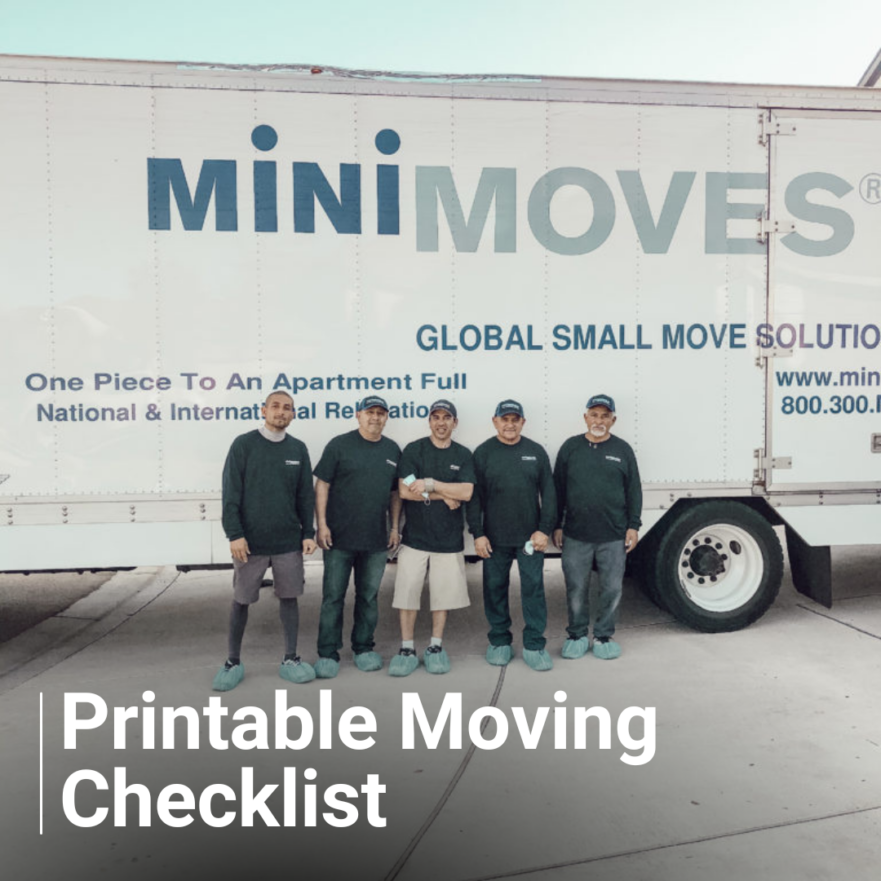Moving Checklist: (feel free to print this out!)
1-2 Months Before Move-
[ ] Create binder/folder for moving records (estimates, receipts, inventory lists, etc.)[ ] Plan your moving method (truck rental, hiring movers, etc) and get cost estimates
[ ] Research storage facilities if needed
[ ] Schedule disconnection/connection of utilities at old and new place
[ ] Phone [ ] Internet [ ] Cable [ ] Water [ ] Garbage [ ] Gas [ ] Electric
[ ] Plan how you will move vehicles, plants, pets and valuables that movers can’t take
[ ] Plan how you will arrange furniture in the new place – use a floor plan or sketch
[ ] Hold a garage sale, donate, sell, or trash unnecessary items
[ ] Schedule transfer of records (medical, children in school, etc.)
[ ] Get copies of any records needed (medical, dental, etc.)
[ ] Acquire packing materials (boxes, tape, paper/padding, markers, etc.)
[ ] Make any home repairs that you have committed to making
[ ] Return borrowed, checked-out and rented items
[ ] Get things back that you have lent out
[ ] Start using up food you have stored so there is less to move
3-4 Weeks Before Move-
[ ] Finalize moving method and make necessary arrangements[ ] Begin packing non-essential items
[ ] Label boxes by room (on the top) and contents (on the side)
[ ] Separate valuable items to transport yourself – label as DO NOT MOVE
[ ] Keep a box out for storing pieces, parts and essential tools that you will want to keep with you on move day – label as PARTS BOX – OPEN ME FIRST
[ ] Create an inventory list of items and box contents for the boxes you’ve packed
[ ] Fill out a Change of Address form at a post office or on-line
[ ] Provide important contacts with your new address:
[ ] Employers [ ] Family & Friends [ ] Attorney [ ] Accountant [ ] Others
[ ] Notify your insurance and credit card companies about change of address
[ ] Cancel automated payment plans and local accounts/memberships if necessary
[ ] Take your vehicle(s) in for a tune-up, especially if you are traveling cross country
1-2 Weeks Before Move-
[ ] Continue packing and clean as you go[ ] Pack items separately that you will need right away at your new place
[ ] Plan to take the day off for moving day
[ ] Find useful things for your children to do – involve them as much as possible
[ ] Find someone to help watch small children on move day
[ ] Begin to pack your suitcases with clothes and personal items for the trip
[ ] Reconfirm your method of moving with those involved
[ ] Make sure your prescriptions are filled
[ ] Empty out your safe deposit box, secure those items for safe travel
[ ] Schedule cancellation of services for your old place
[ ] Newspaper [ ] Housecleaning [ ] Lawn [ ] Pool [ ] Water Delivery
[ ] Check your furniture for damages – the movers will list all pre-existing damage
[ ] Take furniture apart if necessary (desks, shelves, etc.) Movers take beds apart.
[ ] Make sure all paperwork for the old and new place is complete
[ ] If traveling far, notify credit card company to prevent automated deactivation
[ ] Get rid of flammables such as paint, propane, and gasoline
[ ] Try and use up perishable food
2-4 Days Before Move-
[ ] Confirm all moving details and that you have necessary paperwork[ ] Make a schedule or action plan for the day of the move
[ ] Do not plan to fly on moving day so that you are not rushed or rushing the crew
[ ] Prepare for the bundle of moving expenses (moving, food, lodging)
[ ] Continue cleaning the house and discarding things as you are packing
[ ] Defrost your freezer and clean the fridge. Wipe down with water & baking soda.
[ ] Make sure essential tools are handy (screwdrivers, wrench, pliers, tape, etc)
[ ] Pack a bag for water bottles, pen/paper, snacks, documents, and essentials
[ ] Set aside boxes/items that you are moving yourself (make sure you’ll have room)
On Moving Day-
[ ] Remove bedding. The movers will take the beds apart as long as it’s basic disassembly.[ ] Take moving crew through the house to inform them of what is moving/not moving
[ ] Walk through the empty place to check for things left behind – look behind doors
[ ] Leave your contact info for new residents to forward mail
[ ] Get a copy of the mover’s inventory, sign bill of lading, declare a value for your goods.
[ ] Make sure your movers have the correct new address
[ ] Lock the windows and doors, turn off the lights
At your new place …
[ ] Verify utilities are working – especially power, water, heating, and cooling[ ] Perform an initial inspection, note all damages, take photographs if needed
[ ] Clean the kitchen and vacuum as needed (especially where furniture will be going)
[ ] Direct the moving crew where to place things
[ ] Offer drinks and snacks, especially if the move is during the summer
[ ] The movers will assemble your beds as long as it’s basic assembly.
[ ] Begin unpacking, starting with kitchen, bathroom and other essentials
First Couple Weeks After Moving In-
[ ] Check for damages while unpacking – be aware of deadline for insurance claims[ ] Replace locks if necessary and make at least 2 copies of your new keys
[ ] Confirm that mail is now arriving at your new address
[ ] Make sure your previous utilities have been paid for and canceled
[ ] Complete your change of address checklist
[ ] Bank(s) [ ] Credit Cards [ ] IRS [ ] Loans [ ] Insurance [ ] Pension plans
[ ] Attorney [ ] Accountant [ ] Physicians [ ] Family support
[ ] Newspapers [ ] Magazines [ ] Licenses [ ] Memberships
[ ] Schedule a time to get a local driving license and update vehicle registration
[ ] Find new doctors, dentists, etc, depending on your needs & insurance
[ ] After you are moved in, update your home inventory, including photos of rooms
[ ] Update your renters insurance or homeowners insurance if needed
And be sure to let us know if MiniMoves can be of any additional help throughout your moving process!
www.minimoves.com | 800-300-6683





